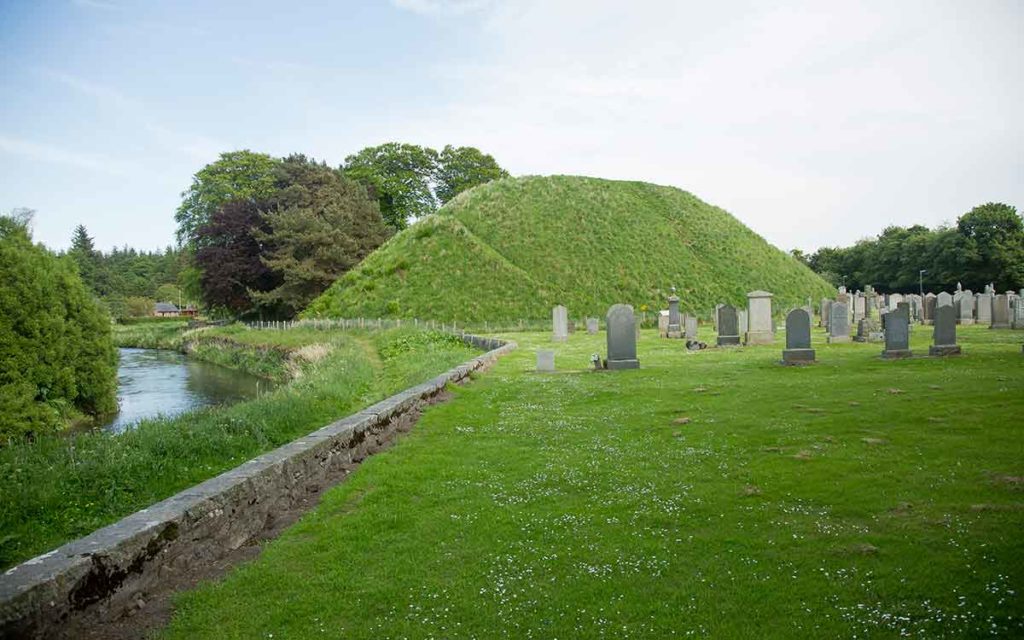A cemetery mound in Aberdeenshire, known as the Bass of Inverurie, has a long and strange past, says guest writer DUNCAN HARLEY

The Bass Motte and Bailey Castle at Inverurie in Aberdeenshire, locally known locally as The Bass of Inverurie, consists nowadays of two riverside flat-topped conical hillocks, the largest of which stands some 12m above the surrounding countryside.
Such castles were once common throughout Scotland, although many have been overlaid by later stone-built fortifications. Indeed, the neighbouring town of Kintore also once boasted a similar motte and bailey structure.
Now gone, it was flattened by Victorian railway engineers during the rush to industrialise Scotland and no obvious trace now remains above ground.
Although nowadays recognised as a naturally-occurring geological feature re-shaped by the castle-builders of the 12th century the Inverurie Bass survives more or less intact but minus, of course, the wooden palisades and drawbridge which no doubt it once boasted.
Legends of the Bass of Inverurie
To this day, legends and fantastical theories abound regarding its origins. A burial mound containing the remains of plague victims, a place of hidden buried treasure, or a fire signal station dating from the times of the Danish invaders are just a few suggestions.
But of course no-one alive today knows the truth of the matter and aside from scant archaeological evidence, the history of the site is up for grabs.
In June 1944, on the very eve of D-Day, the Bass was subjected to intensive study by a paranormal investigator, who concluded that the site was the dwelling place of a group of monstrous spirits, buried by Druids so as to frustrate what he termed the “Evil Earth Magnetism of the Mound of Death!”
John Foster Forbes investigates
That investigator was a local man by the name of John Foster Forbes. Forbes can really only be described as an inquisitive eccentric. Born at Rothiemay in Aberdeenshire in 1889, he had served in the First War as an intelligence officer before embarking on a brief career as a teacher. He had a fascination for prehistory and took to investigating the many Neolithic and Pictish monuments of his home county.
His investigation of the Bass at Inverurie was carried out in the company of a psychic by the name of Iris Campbell who ‘tuned into the mound’ using a procedure known to some as Psychometry. It did not go well.
Seemingly the two psychic investigators were completely traumatised by what they discovered at the site and reports from the time suggest that it took them several days to shake off the malign influence of the ‘Mound of Death’. The mound, they concluded was a burial pit used by Picts to erase a race of evil monsters’ intent on destroying humanity.
Whatever the truth of the matter, the Bass probably once hosted the administrative centre of the earldom of the Garioch during the 12th century. Nowadays of course, it presides over the 1200 or so residents of the town’s Old Cemetery.
Inverurie has, of course, another claim to fame in the form of the 7th century Tomb of Eth of the Swiftfoot. This Pictish burial mound at Conyng Hillock is nowadays little known and lies partially-hidden in a private back garden near Kellands Park in Inverurie. In 1902 fragments of a burial urn – now lost, were found at the site and some charred wood was reportedly dug up.
Local lore suggests that the six-metre-high artificial mound is the resting place of Eth, a Pictish king slain in battle nearby and buried at Inverurie in AD 878. Eth was seemingly named for his “abnormal nimbleness of limb”, enabling him to “outstrip all his fellows in a running match.”
Clearly his extreme nimbleness failed to save him from death in battle however and the jury is still out on the Inverurie burial claim since seeming King Eth is also reputed to be interred amongst a host of other Scottish kings on the west coast island of Iona.
Watch Bass of Inverurie Video
DUNCAN HARLEY is author of The A-Z of Curious Aberdeenshire and The Little History of Aberdeenshire, both titles are available from Amazon.








